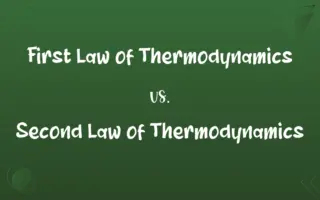Moist Heat Sterilization vs. Dry Heat Sterilization: Know the Difference

By Shumaila Saeed || Published on January 31, 2024
Moist Heat Sterilization uses steam under pressure for rapid heat penetration and sterilization, while Dry Heat Sterilization employs higher temperatures over a longer period to achieve sterilization through oxidative processes.

Key Differences
Moist Heat Sterilization involves the use of steam under pressure, enabling rapid heating and penetration of materials for effective sterilization. Conversely, Dry Heat Sterilization uses dry air heated to high temperatures, necessitating longer exposure times for the sterilization process. The key difference lies in the medium used for heating: steam for moist heat and dry air for dry heat.
Shumaila Saeed
Jan 31, 2024
The effectiveness of Moist Heat Sterilization comes from steam's ability to transfer heat more efficiently, allowing for lower temperatures and shorter sterilization times compared to Dry Heat Sterilization. Dry Heat Sterilization, on the other hand, requires higher temperatures (typically above 160°C) for extended periods to ensure sterilization, making it less energy-efficient but more suitable for materials that can be damaged by moisture.
Shumaila Saeed
Jan 31, 2024
Moist Heat Sterilization is ideal for materials that can withstand moisture and heat, such as surgical instruments and textiles, due to its rapid and effective sterilization capabilities. Dry Heat Sterilization is preferred for materials sensitive to moisture, such as powders, oils, and certain metal instruments, as it avoids the risk of moisture damage.
Shumaila Saeed
Jan 31, 2024
In terms of safety, Moist Heat Sterilization poses a lower risk of material damage for moisture-tolerant items and is generally faster and more energy-efficient. Dry Heat Sterilization, while slower and requiring higher energy consumption, is essential for materials that could be compromised by steam, offering a safe alternative for moisture-sensitive items.
Shumaila Saeed
Jan 31, 2024
Lastly, monitoring and validation of Moist Heat Sterilization are typically achieved through temperature and pressure indicators, ensuring effective sterilization. Dry Heat Sterilization requires specific temperature monitoring over a longer duration to confirm the attainment of sterilization, making the validation process more prolonged and temperature-focused.
Shumaila Saeed
Jan 31, 2024
ADVERTISEMENT
Comparison Chart
Suitability for Materials
Ideal for moisture-tolerant materials
Best for moisture-sensitive materials
Shumaila Saeed
Jan 31, 2024
Energy Efficiency and Safety
More energy-efficient, lower material risk
Less energy-efficient, essential for specific items
Shumaila Saeed
Jan 31, 2024
ADVERTISEMENT
Moist Heat Sterilization and Dry Heat Sterilization Definitions
Moist Heat Sterilization
It involves heating materials with steam under pressure.
The lab used Moist Heat Sterilization to ensure the media was free from contaminants.
Shumaila Saeed
Jan 11, 2024
Dry Heat Sterilization
Dry Heat Sterilization uses hot air for sterilization.
The lab employed Dry Heat Sterilization for their glassware to avoid moisture damage.
Shumaila Saeed
Jan 11, 2024
Moist Heat Sterilization
Moist Heat Sterilization uses steam for rapid sterilization.
Hospitals rely on Moist Heat Sterilization to quickly sterilize surgical instruments.
Shumaila Saeed
Jan 11, 2024
Dry Heat Sterilization
It is less energy-efficient but essential for certain items.
For sterilizing lipid-containing formulations, Dry Heat Sterilization was the preferred method.
Shumaila Saeed
Jan 11, 2024
Moist Heat Sterilization
This method is effective against all types of microorganisms.
Moist Heat Sterilization is a standard practice for sterilizing culture media in microbiology.
Shumaila Saeed
Jan 11, 2024
ADVERTISEMENT
Dry Heat Sterilization
It involves exposing items to high temperatures for a longer duration.
Dry Heat Sterilization was used to ensure the sterility of the powder substances.
Shumaila Saeed
Jan 11, 2024
Moist Heat Sterilization
It is commonly used in healthcare for sterilizing equipment.
Moist Heat Sterilization ensures that the surgical tools are safe and sterile for patient use.
Shumaila Saeed
Jan 11, 2024
Dry Heat Sterilization
This method is ideal for heat-stable, moisture-sensitive materials.
Oily pharmaceutical products were sterilized using Dry Heat Sterilization to maintain their integrity.
Shumaila Saeed
Jan 11, 2024
Moist Heat Sterilization
Moist Heat Sterilization is suitable for heat and moisture-resistant materials.
The clinic preferred Moist Heat Sterilization for its cloth gowns and drapes.
Shumaila Saeed
Jan 11, 2024
Dry Heat Sterilization
Dry Heat Sterilization is effective against all microorganisms.
Dry Heat Sterilization was chosen for metal instruments to avoid rusting.
Shumaila Saeed
Jan 11, 2024
Repeatedly Asked Queries
What is Moist Heat Sterilization?
Moist Heat Sterilization is a method of sterilization using steam under pressure, typically at temperatures of 121-134°C.
Shumaila Saeed
Jan 31, 2024
What is Dry Heat Sterilization?
Dry Heat Sterilization is a sterilization process using dry air heated to temperatures above 160°C.
Shumaila Saeed
Jan 31, 2024
What items are suitable for Dry Heat Sterilization?
Dry Heat Sterilization is ideal for moisture-sensitive items like powders, oils, and certain metal tools.
Shumaila Saeed
Jan 31, 2024
How long does Moist Heat Sterilization take?
It can range from a few minutes to an hour, depending on the item and sterilizer type.
Shumaila Saeed
Jan 31, 2024
What are the typical uses of Moist Heat Sterilization?
It's commonly used for sterilizing surgical instruments, textiles, and culture media in healthcare and laboratory settings.
Shumaila Saeed
Jan 31, 2024
How long does Dry Heat Sterilization typically take?
It usually takes a longer time, from 1 to several hours, depending on temperature and item type.
Shumaila Saeed
Jan 31, 2024
Is Moist Heat Sterilization energy-efficient?
Yes, it is generally more energy-efficient compared to dry heat methods.
Shumaila Saeed
Jan 31, 2024
Are there any risks associated with Moist Heat Sterilization?
The main risk is potential damage to moisture-sensitive materials.
Shumaila Saeed
Jan 31, 2024
Is Dry Heat Sterilization effective against all microorganisms?
Yes, when used correctly, it is effective against all types of microorganisms.
Shumaila Saeed
Jan 31, 2024
Can Moist Heat Sterilization be used for powders?
Generally, no. Powders may be damaged or altered by the steam.
Shumaila Saeed
Jan 31, 2024
How is Moist Heat Sterilization monitored?
It's monitored using temperature and pressure indicators.
Shumaila Saeed
Jan 31, 2024
What types of materials are best for Dry Heat Sterilization?
It's best for heat-stable, moisture-sensitive materials like oils, powders, and some metal instruments.
Shumaila Saeed
Jan 31, 2024
What is the main advantage of Moist Heat Sterilization?
Its main advantage is the rapid and effective sterilization of heat and moisture-tolerant materials.
Shumaila Saeed
Jan 31, 2024
Can Dry Heat Sterilization damage materials?
It poses a lower risk of moisture damage but may not be suitable for heat-sensitive materials.
Shumaila Saeed
Jan 31, 2024
Can Moist Heat Sterilization be used for electronic equipment?
Generally, it's not suitable for electronic items due to the risk of moisture damage.
Shumaila Saeed
Jan 31, 2024
Is Dry Heat Sterilization more time-consuming than moist heat?
Yes, it generally requires a longer time to achieve effective sterilization.
Shumaila Saeed
Jan 31, 2024
What is a key benefit of Dry Heat Sterilization?
Its ability to sterilize moisture-sensitive and heat-stable materials without causing damage.
Shumaila Saeed
Jan 31, 2024
How do you validate Dry Heat Sterilization?
Validation is done by monitoring and maintaining specific temperatures for a set duration.
Shumaila Saeed
Jan 31, 2024
Can Moist Heat Sterilization cause rusting of instruments?
There is a possibility of rusting if instruments are not properly dried after sterilization.
Shumaila Saeed
Jan 31, 2024
Is Dry Heat Sterilization suitable for plastic items?
Typically, no. High temperatures may melt or deform many plastics.
Shumaila Saeed
Jan 31, 2024
Share this page
Link for your blog / website
HTML
Link to share via messenger
About Author
Written by
Shumaila SaeedShumaila Saeed, an expert content creator with 6 years of experience, specializes in distilling complex topics into easily digestible comparisons, shining a light on the nuances that both inform and educate readers with clarity and accuracy.









































































